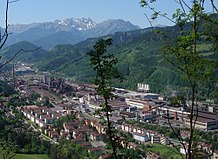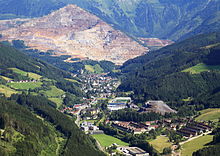Austrian-Alpine Montangesellschaft
| Austrian Alpine Mining Society (ÖAMG) | |
|---|---|
| legal form | Corporation |
| founding | 1881 |
| resolution | 1973 (merger with VÖEST to form Voestalpine ) |
| Seat | Donawitz , Styria |
| Branch | Iron production and processing |
The Oesterreichisch-Alpine Montangesellschaft (ÖAMG) was a stock corporation founded on July 19, 1881 in the buildings of the Länderbank (Vienna) , which is now part of the Voestalpine Group. The main aim of this company was to unite the production of mines and metal industry under one central administration.

Emergence
The Oesterreichisch-Alpine Montangesellschaft emerged from the merger of the Vordernberg-Köflacher Montangesellschaft, the Neuberg-Mariazeller and the St.-Agidi-Kindberger Montangesellschaft. The ÖAMG tried to steer the structural change in the iron industry in such a way as to concentrate production in those places that had good rail connections, while businesses in side valleys such as B. Aschbach and Neuberg , but also small locations in southern and western Styria such as Eibiswald were quickly closed. In fact, with the merger of companies, efficiency could be increased significantly. As the legal successor to the Innerberger Main Union , the ÖAMG came into possession of a large number of properties and real estate, including historically valuable mansions, hammer mills and forest houses.
Establishments
The core areas of ÖAMG were primarily the industrial plants around the Styrian Erzberg , namely the blast furnace , steel and rolling mills in Donawitz ( Donawitz smelting works ) and blast furnace plants in Eisenerz and Hieflau , as well as the Zeltweg machine factory in the Mur-Mürz-Furche , which is made up of developed in a smelting company and today enjoys worldwide recognition in railway switch construction. The Kindberg and Krieglach operations as well as those already mentioned in Neuberg and Aschbach and Gußwerk still existed in the Mürz Valley .
The second largest core area was in Carinthia , namely around the Hüttenberger Erzberg with the locations Hüttenberg, Lölling , Heft, Mosinz , Brückl and Treibach .
Outside of Styria and Carinthia, there were iron and steel works in Schwechat and Krems . In addition to these, the company also owned coal mines , especially in Fohnsdorf , Seegraben and Köflach (all Styria), the ore mines of Eisenerz , Radmer and Hüttenberg as well as extensive forest areas.
Of the companies mentioned, only the Donawitz ironworks , the companies in Zeltweg and Kindberg and the Krems hut still exist .
History until 1938
1912 was the company's productive record year, at that time it had four coal mines, two ore mines and six iron and steel works. Karl Wittgenstein (from 1897), Hugo Stinnes (1921–24) and, in the meantime, the speculator Camillo Castiglioni were among the entrepreneurial personalities who at times strongly shaped Alpine Montan . In the later interwar period, Alpine Montan, under the leadership of Anton Apold, was considered a prime example of a politicized company that promoted yellow unions (including the Independent Union ) and Heimwehr (especially the Styrian Homeland Security ) and thus stood in sharp contrast to the political left. At that time, the United Steel Works (VESTAG, Düsseldorf) acted as owners . At the turn of 1932/33, Alpine finally turned to the NSDAP and supported them financially and logistically, even during the July coup .
History since 1938
After the " Anschluss ", Alpine Montan became part of the Reichswerke Hermann Göring . Even after 1945 it remained nationalized for decades and belonged to the Austrian Industrial Holding (ÖIAG) .
In 1958, the ÖAMG took over the rolling and steel works founded by Johann Haselgruber in St. Andrä-Wölker and continued it until 1967.
The technological milestone in steel production was the development of the LD ( Linz-Donawitz process ) blown steel process, initiated in 1952 , named after the Linz ( VOEST) and Donawitz sites (the VOEST that emerged from the Hermann Göring works ). This technology has largely replaced all previous processes worldwide.
In 1973 the company merged with VÖEST (Vereinigte Österreichische Eisen- und Stahlwerke AG). The acquisition of Gussstahlwerke Judenburg , Schoeller-Bleckmann Stahlwerke ( Mürzzuschlag -Hönigsberg) and Böhler-Werke ( Kapfenberg ) turned out to be a bad acquisition . After another restructuring in 1987, which was accompanied by extensive staff cuts, the crisis-ridden group recovered.
Today the voestalpine Group is a strongly modernized company. The longest railway tracks in the world are produced in Donawitz and Duisburg (120 meters). A special head hardening gives them an above-average service life. Together with Zeltweg , voestalpine Bahnsysteme are leaders in the world market. Another quality segment is wire production .
General directors of the ÖAMG were u. a. Anton Apold , Hans Malzacher and Josef Oberegger .
Locomotive construction at ÖAMG Zeltweg
In the 1950s and 1960s, ÖAMG Zeltweg built a number of electric and diesel-electric locomotives for normal and narrow gauge. As a supplier of smaller quantities, the company was able to compete with the two other (state) locomotive companies SGP and Jenbacher and offer more individual solutions for small companies. The electrical equipment of all ÖAMG locomotives built came from the Austrian Brown Boveri works in Vienna, the diesel engines from MAN . BBC may have been the contractor who outsourced the manufacture of the mechanical part to ÖAMG. The built locomotives turned out to be solid constructions, e.g. Some of them continue to serve without complaint to this day.
At least three types of locomotives were made. The start was made in 1957 with the four-axle E 3 electric locomotive in Bosnian gauge for the Mixnitz-St. Erhard (serial number 1601/1957). It was followed by another in 1963 (E4, serial number 2402/1957). These locomotives with a Bo´Bo´ wheel arrangement are driven by four BBC DC motors with 37 kW each. Both locomotives are still in operation today and handle all traffic on this line.
In the first half of the 1960s a Bo'Bo 'narrow-gauge diesel locomotive was developed for the Styrian State Railways and built from 1964 to 1967 as the StLB VL 11-16 .
At the same time as the narrow-gauge locomotives, a three-axle type for standard gauge was also developed. The first machine of this type with axles mounted in the frame, type Co-de, was delivered to the Heraklithwerk Ferndorf in 1960, it made 400 HP and was named C400 / 45. Further locomotives were built from 1964 for the StLB and the Graz-Köflacher-Bahn . With the GKB they were named DE 750.1 to 750.3 (last written as V 7501 - V 7503) and with the StLB DE 1 and DE 2. These locomotives with the maximum speed of 60 km / h solved on the GKB and the Landesbahn Gleisdorf-Weiz largely cut off steam traction, they were used in passenger and freight traffic as well as in shunting operations. The locomotives were 9.5 meters long, weighed 48 tons and had an output of 551 kW. The main engine was initially a V-12 two-stroke diesel engine of the type MAN V 6 V 16 / 18T, which drove a direct current generator from BBC. The diesel engines, however, tended to have leaky cylinder liners and were therefore exchanged for MTU eight-cylinders on most of the machines. The GKB decommissioned its locomotives in 1993 and scrapped them in 1995, with the StLB DE 2 is still in service for freight trains and shunting tasks.
Overview of the locomotives built by ÖAMG Zeltweg
- Mixnitz-St.Erhard E3, type Bo´Bo´E, track width 760 mm, built in 1957, serial number 1601 - still in service
- Mixnitz-St.Erhard E4, type Bo´Bo´E, track width 760 mm, built in 1963, serial number 2402 - still in service
- StLB VL 11 - 16, type Bo´Bo´De, track width 760 mm, years of construction 1964-1967, serial numbers 2836, 3260, 3618-3621 - VL 12, 13 and 16 still in service
- Heraklith Ferndorf locomotive 2, type Co´De, standard gauge, built in 1960, serial number 1976 - still available as a 2010 reserve
- StLB DE 1 - 2, type Co´De, standard gauge, years of construction 1964 a. 1965, serial numbers 2393 and 2854 - DE 2 still in service, DE 1 spare parts dispenser
- GKB V750.1 - 3, type Co´De, standard gauge, years of construction 1964, 1965 and 1969, serial numbers 2852, 2853 and 3057 - scrapped in 1995
E 4 of the Mixnitz-St. Erhard , built in 1963
Diesel-electric narrow-gauge locomotive VL 12 of the Steiermärkische Landeseisenbahnen , built by ÖAMG Zeltweg and BBC in 1966.
literature
- Kurt Bauer: Structure and dynamics of illegal National Socialism in the Upper Styrian industrial region 1933/34. Vienna 1998, especially p. 28 ff. (Vienna, University, diploma thesis 1998 (fully included in the WEB)).
- Fritz Erben, Maja Loehr, Hans Riehl (eds.): The Austrian-Alpine Montangesellschaft. 1881-1931. Self-published by the society ao, Vienna ao 1931.
- Otto Hwaletz: The Austrian coal and steel industry in the 19th and 20th centuries (= studies on economic history and economic policy. Vol. 6). Böhlau, Vienna et al. 2001, ISBN 3-20599086-2 .
-
Oliver Rathkolb (Ed.): Nazi Forced Labor: The Linz Site of the Reichswerke Hermann Göring-AG Berlin, 1938–1943. Böhlau, Vienna et al. 2001, ISBN 3-205-99417-5 ;
- Volume 1: Christian Gonsa, Gabriella Hauch, Michael John, Josef Moser, Bertrand Perz , Oliver Rathkolb, Michaela C. Schober: Forced labor - slave labor: Political, social and economic history studies.
- Volume 2: Karl Fallend: Forced labor - slave labor in the Reichswerke Hermann Göring in Linz. (Auto) biographical insights.
- Barbara Schleicher: Hot iron. On the corporate policy of the Österreichisch-Alpine-Montangesellschaft in the years 1918–1933. Lang, Frankfurt am Main et al. 1999, ISBN 3-631-33202-5 (At the same time: Halle-Wittenberg, University, dissertation, 1998: In tow of the German steel industry. ).
Individual evidence
- ^ Reinhold Jagersberger: mansions of the hammer gentlemen, wheel masters and ironworkers in Styria . Verlag für Collectors, Graz 2015 ISBN 978-3-85365-275-6 p. 35
- ↑ Helmut Wittmann (Red.): The book of the Murtalbahn . Ed .: Steiermärkische Landesbahnen - Directorate. Steiermärkische Landesbahnen - Directorate, ISBN 3-901474-02-1 , p. 92 .
- ↑ Müller, Prokop, Straka, Erhard, Moser, Böhm, Zehetner, Schindler: The Mixnitz - St. Erhard local railway . Railway-Media-Group, Vienna 2018, ISBN 978-3-902894-40-3 .
- ↑ Gottfried Aldrian, Andreas Konecnik: 150 years Graz-Köflach Railway . Sutton Verlag, Erfurt 2010, ISBN 978-3-86680-701-3 , p. 54-55 .
- ↑ EINST und NOW - Pictures from the GKB - page 2. Accessed on October 17, 2019 .
Web links
- Entry on Oesterreichisch-Alpine Montangesellschaft in the Austria Forum (in the AEIOU Austria Lexicon )
- schlot.at : ÖAMG: blast furnaces, gas power station, slag mountain in Münichtal / Eisenerz - historical photos and views
- Roman Sandgruber: The state made of steel - VOEST and Alpine Montangesellschaft. In: Die Presse , September 20, 2003.
- Early documents and newspaper articles about the Austrian Alpine Mining Society in the 20th century press kit of the ZBW - Leibniz Information Center for Economics .
- http://www.ralfsrailwayresort.de/A/StLB/StLB_V_DE2_C_Weiz.jpg Picture of DE 2 in Weiz in current condition.


